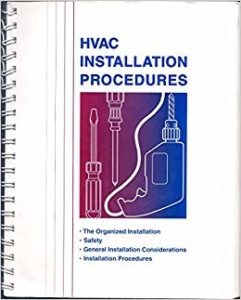HVAC Installation Procedures
HVAC Installation Procedures
HVAC Installation Procedures provides the basic information needed to plan and prepare for the installation of residential and light commercial air conditioning and heating systems. Planning the installation and an overview of the tasks and sequence for a typical installation are covered first, followed by a brief description of the tools used to perform common installation tasks. Also given in this section are guidelines for acquiring and maintaining good customer relations before, during, and after the installation.
Every HVAC Installer should have this rugged, 200-page, on-the-job reference book. Printed on specially coated paper, it includes sections on hand and power tools, piping practices, electrical hook-ups and duct installation. Additional sections cover installation and split systems, furnaces and packaged heating and cooling products. Valuable start-up and checkout sheets are included.
You can also Read Fundamentals of refrigeration thermodynamics
HVAC Installation Procedures Contents
- The organized installation
![HVAC Installation Procedures]()
- Safety
- Installing fasteners and anchors
- Rigging, hoisting, and moving
- piping System
- Forced Air duct system
- Field wiring
- Gas furnace installation
- split system installation
- package unit installation
- Appendix
- Glossary
- index
- Tool list
Installation Menu
- Planning the installation
- Typical installation tasks and sequence
- Installation and startup checklists
- Installation tools and equipment
- Hand Tool Set
- Measuring and Layout Tools
- Portable Electric and Cordless Tools
- Ladders
- Customer relations for installers
A variety of mechanical fasteners such as nails, screws, and anchors are used when installing HVAC equipment. Use of the wrong fasteners or improper installation of fasteners can cause injury to people, damage to the equipment, or both. For these reasons, the HVAC installation technician must know the capabilities of fasteners, be able to select the correct kind for the job, and install them properly.
Installation jobs require the movement of heavy equipment, materials, and tools from one place to another. This task, called rigging, involves the use of special moving devices such as hand trucks, dollies, hoists, cranes, and related accessories. Rigging is a skilled profession and should always be performed by qualified riggers.


Comments are closed.